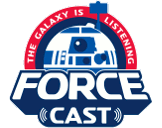This essay is from John Booth
Published on May 28th, 2004
Still A Rebel: 'The Mystery of the Rebellious Robot' Turns 25
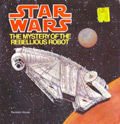
In 1978, few things were bigger than Star Wars.
Yet with George Lucas' big screen return to his universe still to come, the Star Wars realm he had created remained comparatively small.
Fans were familiar with the sweltering Mos Eisley air and the jungle cries rising above the surface of the fourth moon of Yavin, but with only fleeting teases to the worlds of Alderaan and Dantooine, there seemed so much more worth seeing.
Marvel's comics were already taking the first steps into the unexplored regions of the post-Episode IV galaxy, and Alan Dean Foster's novel Splinter of the Mind's Eye presented a new tale of Luke and Leia stranded on an Imperial-controlled swamp planet.
It was into this world that 23-year-old New York City-born artist Mark Corcoran stepped, making his mark with one of the first forays into expanding the Star Wars universe with a story expressly aimed at younger fans.
"Star Wars: The Mystery of the Rebellious Robot," published by Random House in 1979, is a tale of droids run amok, mischievous jawas, and a scientific quest to build a super vaporator on Tatooine.
That same year, Random House also released "The Maverick Moon," illustrated by Walter Wright and another book clearly for younger readers. Neither book carries an author's credit, and Corcoran says the publishers simply gave him the completed story to work with.
But where Wright's illustrations take a fairly straightforward approach to the Star Wars characters and settings, Corcoran's offered one of the earliest stylized interpretations of Lucas' world outside of the comics: Chewbacca's mane takes on a multicolored, zero-gravity wildness; there's a wonderfully exaggerated Han Solo sneer coupled with a puzzlement perfectly captured in his eyes; and even in the blackness of space, a terrifically detailed Millennium Falcon is vibrantly accented with color and shadow.
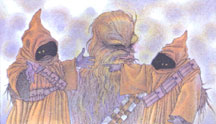
From the frayed edges of jawa robes to a collapse of dust and debris onto Han, Chewie and C-3PO, there is a life and movement to Corcoran's illustrations that fits well with Lucas' vision of a lived-in universe.
Decades later, Star Wars fans have grown used to seeing their favorite universe through different eyes, most notably in Topps' Star Wars Galaxy series of trading cards, and recently on the Cartoon Network's Clone Wars animated series.
But even now, Corcoran feels like his work was a bit on the Outer Rim.
"The overall way the thing looks is just how (my art) looked at the time," he reflects. "It's a book I've had a little bit of anxiety about. It seemed so out of step with the usual."
That anxiety wasn't helped by the pressure of a quick turnaround time. The Star Wars tsunami, after all, was still in full force, and the demand for tie-ins was high.
"It was one of those cases of ridiculous deadlines, or at least what I considered ridiculous," Corcoran admits. "I also guess I was relatively inexperienced, and it wasn't a style (of drawing) that was conducive to speed, at least for me."
To deal, in part, with that stress, Corcoran gave a nod toward the subtle details and sly humor he'd enjoyed so much in Star Wars, which he saw for the first time with a group of art school friends and fellow science-fiction fans.
"The visuals were all spectacular - and the humor that ran throughout, with C-3PO and the little incidentals," he remembers. "The design of the ships and all that was wonderful. We got a tremendous kick out of it."
Consequently, his favorite bits in "Rebellious Robot" are the ones which sneak up quietly.
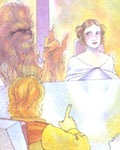
One such moment depicts Chewbacca holding aloft a pair of rascally jawas. One of the diminutive creatures is pointing a finger of blame at the other, who is simply shrugging in acknowledgment. It is a very human moment captured ideally within the frame of Lucas' alien environment.
"Chewie springing at the jawas I like," Corcoran says, leafing through a copy of the book. "The humor and character were able to come through in that one."
The illustrator is also proud of a picture which features several of the main characters in an animated group discussion.
"There's a roundtable, and there's sort of a way that Princess Leia is kind of looking at the Wookiee, who is doing a gesture, and it's kind of like, 'Oh, realllllly,'" Corcoran says, drawing the last bit out in a faux-British accent. "So there are certain things, gestures or what-have-you that you throw in to please yourself that are a little sly or a little amusing."
At least one of the illustrator's attempts went awry: a double-page spread featuring a cockpit shot of Han and Chewie on the left and the Falcon on the right may seem in order, but Corcoran says the spread was printed upside down, negating his original intention of trying to capture a sense of the freighter's uncontrolled flips through space.
Corcoran was provided with reference photos to help maintain a level of accuracy to detail, especially on the more technical aspects of the droids and spaceships.
Probably the most familiar-feeling illustration, though - Threepio emerging from an oil bath in a room which bears a striking resemblance to the Lars' family garage - was drawn largely from Corcoran's memory of an identical scene in Star Wars.
"That one, oddly enough, may have been improvised," he recalls. "I think I was sort of winging it in that one, just generally remembering what it looked like."
Another personal favorite is an inset showing the Falcon as a reflection in a close-up shot of Luke's visor.
Then, he admits, there are some panels that seem "lackluster."
"Chewbacca was tricky. Sometimes he works, sometimes he doesn't, with that watery rainbow thing going on all over him."
Now 48, Corcoran says he was simply born to draw, and it didn't take long for his passion and creativity to set him on an artist's path while growing up in New York.
"As far back as I can remember, it kind of always seemed it was something I would do," Corcoran said. "Thankfully, I was encouraged."
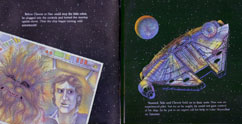
He studied at the Parsons School of Design in his hometown, where his instructors included, in one special case, Maurice Sendak, author and illustrator of the timeless "Where the Wild Things Are."
In art school, Corcoran encountered like-minded artists who'd feasted on Superman comics and monster movies as kids and had gotten hooked on science fiction when they got a little older.
(True story: Corcoran sought permission to cut Sendak's class one day to attend a Star Trek convention and show off some drawings he'd done of Spock's ears. He got the green light.)
And then, leading up to the spring of 1977, Corcoran and his pals saw some eye-popping paintings by a guy named Ralph McQuarrie, and someone in the group had gotten hold of an advance program for Star Wars.
"My friends and I knew it was coming, being sci-fi fans and movie fans," Corcoran says. "And off we all went, on the first day."
Corcoran's appearance on Lucas' grand stage turned out to be a brief one. He worked on the book in 1978 and has only one recollection of a Star Wars connection after "The Mystery of the Rebellious Robot" was published the following year.
"Random House did send me a couple of passes to see The Empire Strikes Back," Corcoran notes. "I remember thinking that Cloud City and Bespin would have made a very nice Krypton, because it was the way it had always been drawn in the comics."
Corcoran has continued to work as an artist in the years since, creating illustrations for children's textbooks and magazines like "Highlights," which featured his work twice in 2003 with more to come this year. He has also been working toward his own written and illustrated children's book.
"Kids' stuff lends itself to a sense of humor, and, oh, I don't know, a sense of whimsy," Corcoran . "In many ways, I've hung onto the kid in me."
And while he's never returned, at least artistically, to that galaxy far, far away, Corcoran remains amazed at the lasting impact Star Wars, once anticipated as a sci-fi fringe work, has had on popular culture.
"It just seems like a fact of life now," he says. "There's so much that has been spawned in its wake."
John Booth is an Ohio writer and a member of the Ohio Star Wars Collectors Club.
Copyright 2004 by John Booth.
Feedback welcome
